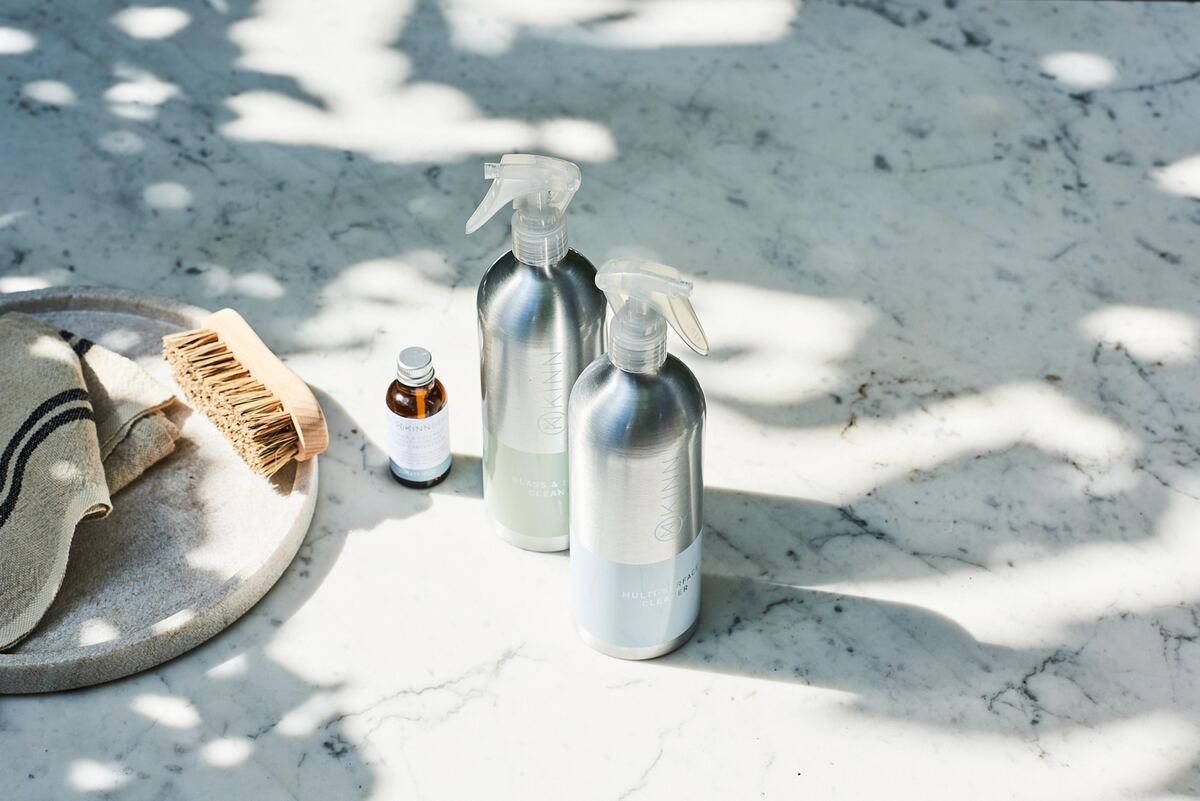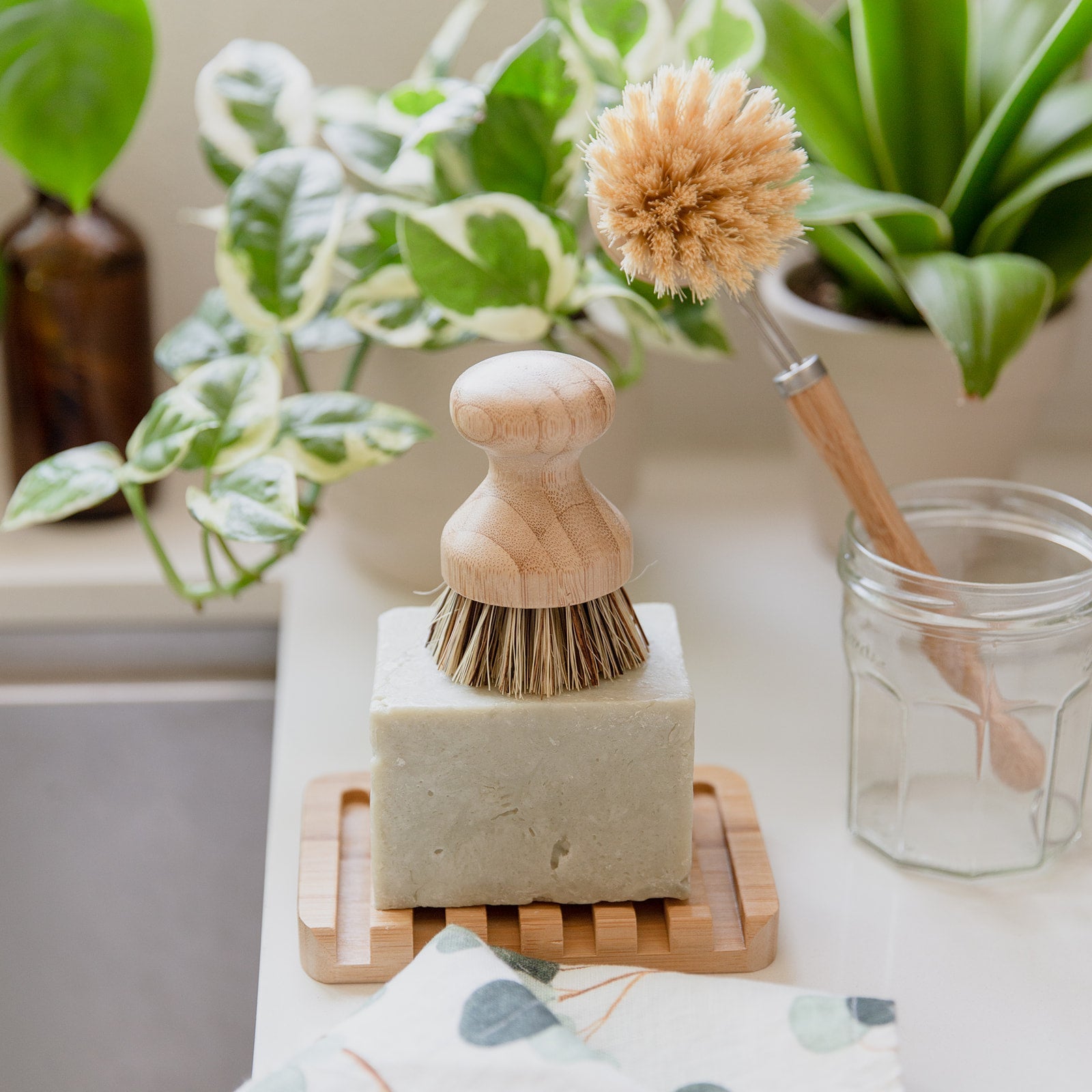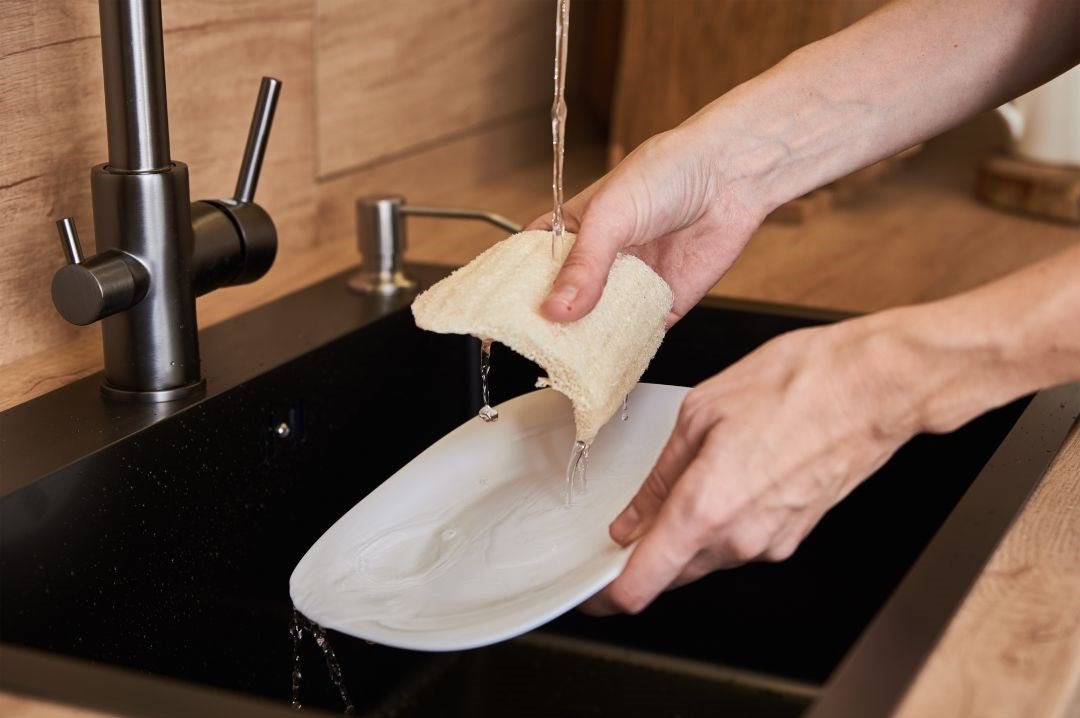Make Your Own Non-toxic Cleaner for Every Surface in Your Home—16 Easy Recipes Included

Have you heard of Joseph Lister, a 19th century scientist who may be indirectly responsible for why you’re now reading this article?
When Joseph discovered the antiseptic property of carbolic acid in the mid 1800s, he had no idea that, in addition to significantly reducing surgical mortality and making him very famous, it would lead to the production of carbolic acid-based soap called Lifebuoy—the first commercial soap ever made. He also had no clue that Lifebuoy would quickly make its way into thousands of homes and start a commercial cleaner revolution. The kind of revolution that will later warrant an entire supermarket aisle dedicated to products just like Lifebuoy.

This spring, skip the trip to the cleaning aisle and make your own natural cleaners using just a few common household items. Photo by Olga Solomon.
Another thing that Joseph probably did not anticipate is that, years later, it will be discovered that carbolic acid is mildly harmful to people. Not as bad as ammonia or any of the other 150 known toxins in the average 21st century home that irritate mucous membranes and cause allergies, cancer, birth defects and psychological abnormalities, but still bad enough to be removed from Lifebuoy's ingredients list.
Spring cleaning is supposed to signify renewal and rebirth, but unfortunately, for many renters and homeowners it's still synonymous with wheezing, headaches, or worse. We have no quarrels with Joseph or Lifebuoy and their contribution to elevating the standard of modern living, but we do have a problem with continuing to use products that cause damage to us and our planet.
“Spring cleaning is supposed to signify renewal and rebirth, but unfortunately, for many renters and homeowners it’s synonymous with wheezing, headaches, or worse.”
The good news is there is a cleaner, more natural way to spring clean.
According to the American Frugal Housewife, a fascinating read on housekeeping in the early 19th century, or your grandma (depending on whom you trust more on the matter), there are plenty of natural cleaners you can buy or make yourself using everyday pantry staples. They will do the job as effectively as all that chemical-laden, fancy-packaged stuff—for a fraction of the cost. If you go the DIY route, you'll need just a few essentials:
-
White Vinegar: Vinegar’s acidity makes for a versatile cleaner that’s very effective at breaking down molds, grease, and bacteria. It should not be used on porous surfaces such as wood or marble countertops as it may cause discoloration.
-
Soda: This deodorizing, sanitizing and stain-removing substance packs a powerful scouring punch when mixed with a little bit of water and soap. Combined with vinegar, it creates a foaming reaction that could help dislodge dirt from hard-to-reach places. However, in terms of cleaning power, vinegar and soda basically cancel each other out, so it is best to use them separately.
-
Castile Soap: Hailing from the Castile region of Spain, Castile soap consists of olive oil, water, and lye (a cleaning agent made from fat, ash, and water). Castile soap is a surfactant, which means it picks up dirt and cuts through grease. Unlike vinegar, Castile soap is PH neutral and is safe to use on wood or marble.
-
Essential Oils: They smell divine and many have antiviral or antibacterial properties. We recommend stocking up on pine, lemon, tea tree, lavender, and eucalyptus oils as they are the most common. However, if you’re sensitive to essential oils, it’s best to leave them out. Your cleaner will still be as effective without them.
-
Lemon Juice: A fantastic, great-smelling degreaser and bleaching agent, lemon juice can help add that extra level of spic and span to glass or lighter surfaces. It also helps mask the smell of vinegar. Lemon juice is a powerful acid, so don’t use on brass, marble, or other porous surfaces as it may discolor them.
-
Hydrogen Peroxide: The typical 3% hydrogen peroxide you’ll find at your local pharmacy is a natural disinfectant suitable for a lot of lighter, non-wood surfaces. When used in cleaners, it acts as bleach. DO NOT mix with vinegar as the reaction produces harmful fumes.
-
Rubbing Alcohol: In the olden days, housewives used rum, but today you can grab a bottle of rubbing alcohol to disinfect many areas in your home. Make sure to get one that’s 70% isopropanol, not 90%—it is actually more effective at killing bacteria and other nasties around your home.
-
Salt: Great for scouring and stain removal, salt can be added for extra help with tougher kitchen and bathroom messes. You can use any salt except Epsom.
-
Filtered Water: When cleaning, it’s best to use filtered water to make sure you’re not spreading any contaminants that may be lurking in your tap.
-
Spray Bottles: For most DIY all-purpose cleaners, we recommend reusable glass bottles. If you’re using hydrogen peroxide in your recipe, then opt for a dark glass bottle. Just keep in mind that it might be more difficult to recycle.
-
Plant-based Cleaning Tools: Grab a few of Earth Ahead’s compostable natural sponges and scrubbers to get the job done right and keep unnecessary plastic out of our landfills and waterways.
Let’s roll up our sleeves and get to work.
In this section, we’ll cover how to make basic cleaning solutions for a variety of different surfaces. However, if you’re pressed for time and would rather buy something ready-made, we totally get it. Try this natural and biodegradable Meliora All-purpose Cleaner and Cleaning Scrub, or this amazing line of Humble Suds All-purpose cleaners.

Here are few simple non-toxic cleaner recipes will keep your home looking great and are completely safe for you and the environment.
As with all cleaners, always try your DIY cleaner on a small inconspicuous area first.
Wood Floors
Step 1. Give your floor a good sweep and remove any stuck-on dirt.
Step 2. Grab a bucket and add 1 tablespoon of Castile soap per gallon of warm water. Do not use vinegar or any other acidic substance as it may damage the wood over time.
Step 3. Add a few drops of pine or tea tree oil if you like the scent. Start with 5-10 drops per gallon of liquid. You can always add more if you like but we don’t recommend going over 20 drops.
Step 4. Use a microfiber mop to clean in the direction of the wood boards.
Carpets
Step 1. If you see any stains, mix a teaspoon of soda with a little bit of water to create a paste and then rub it into the discolored area. For tough stains like wine or chocolate, a tiny bit of hydrogen peroxide might work better. But be careful, too much hydrogen peroxide might bleach the surrounding area and leave yellow circles. Allow the stain to dry.
Step 2. Vacuum your carpet to remove any loose dirt and baking soda.
Step 3. Create a DIY rug shampoo by mixing 1 tablespoon of Castile soap per gallon of hot distilled water. Pour the liquid into your carpet cleaner and give your carpet a good wash.
Step 4. Rinse the area with filtered water.
Step 5. Mix 1 part of white vinegar with 4 parts of filtered water and add it to the rinse reservoir of your carpet cleaner. Go over the area again to wash away any remaining traces of soap.
Tile Floors
Step 1. Grab a bucket and add 1 tablespoon of Castile soap per gallon of warm water. Add ¼ cup of white vinegar if you are cleaning porcelain tile (omit for porous ceramic tile).
Step 2. Add a few drops of your favorite essential oil if you like. Start with 5-10 drops per gallon of liquid.
Step 3. Mop your floor.
Step 4. Rinse your mop in clean water and mop again to remove all traces of soap.
Walls
Step 1. Add up to ¼ cup of Castile soap to a bucket of hot water. You can also add a few drops of your favorite essential oil to scent the solution.
Step 2. Use a clean soft sponge or cloth to remove any spots or fingerprints off your walls.
Marble Countertops
Step 1. Mix a tablespoon of Castile soap per gallon of water. Stay away from any acids or bleaching agents, such as lemon juice, vinegar, or hydrogen peroxide. They may discolor the porous stone.
Step 2. Use a spray bottle to spray the countertop, then use a sponge to clean it.
Step 3. Go over the area in circular motion with a microfiber cloth.
Stovetop and Sink
Step 1. Make your own cleaner by mixing soda with a little water to create a paste. You can also add a teaspoon of salt for some extra scouring power.
Step 2. Take a sponge and work the paste into all the nooks and crannies. Let it sit for a few minutes.
Step 3. Make your own degreasing spray by mixing ½ cup of lemon juice with 2 cups of white vinegar in a spray bottle.
Step 4. Spray the area and wipe down with a damp sponge or cloth.
Stainless Steel Surfaces
Step 1. Stainless steel is non porous so you can use rubbing alcohol or vinegar to clean it. You can also add some lemon juice to either substance to mask the smell.
Step 2. Use a microfiber cloth in the direction of the grain to get rid of streaks and polish the surface.
Oven
Step 1. Mix soda with a little water to create a paste.
Step 2. Use a damp sponge to apply evenly inside your oven.
Step 3. Repeat this process over the next couple days. You can use the oven as usual.
Step 4. Mix 1 part vinegar with 1 part water in a spray bottle.
Step 5. After cooking, while the oven is still warm, spray it with the vinegar solution.
Step 6. Use a regular cloth to wipe down everything and then use a microfiber cloth to polish the surface.
Microwave
Step 1. Fill a bowl with water.
Step 2. Squeeze half a cup of lemon juice and drop the lemon leftovers into the bowl.
Step 3. Microwave the mixture for about 2-3 minutes and then let it sit there for a few more minutes.
Step 4. Wipe down the inside of the microwave with a clean cloth.
Glass and Mirrors
Step 1. Make your own glass cleaner by mixing 3 cups of water with ¼ cup of rubbing alcohol and ¼ cup of white vinegar. Add 10 to 20 drops of your favorite essential oil (we like peppermint or lemon).
Step 2. Pour the solution into a spray bottle and spray the area you want to clean.
Step 3. Wipe down with a cloth or this adorable paper towel replacement.
Step 4. Go over the area again with a microfiber cloth in circular motion.
Shower or Bathtub
Step 1. Mix 1 part salt with 3 parts vinegar. Add a few tablespoons of lemon juice to mask the smell of vinegar.
Step 2. Apply the solution with a sponge or a brush like this one to clean the area.
Step 3. Rinse with warm water.
Grout
Step 1. Combine baking soda with a bit of hydrogen peroxide into a paste.
Step 2. Use a small brush to work it into the grout and leave for about an hour.
Step 3. Clean it off with a sponge and then rinse with water.
Toilet
Step 1. Combine 1 ¼ cup of baking soda with ¼ cup of Castile soap and ¼ cup of rubbing alcohol. Add 10 drops of your favorite essential oil and mix to form a paste.
Step 2. Apply to the areas you want to clean and wait 5-10 minutes.
Step 3. Pour some vinegar into a spray bottle and spray inside and on the toilet.
Step 4. Flush the toilet and wipe down the outside of the toilet with a clean cloth.
All-purpose Cleaner
We prefer this non-vinegar recipe that can be safely used on many different surfaces.
Step 1. Mix 1 teaspoon of Castile soap per cup of filtered water in a spray bottle. Add a few drops of your favorite essential oil (optional).
Step 2. Use a clean microfiber cloth to wipe down surfaces.
All-purpose Scouring Paste
Adds some extra oomph to any cleaning job.
Step 1. Mix ½ cup of baking soda with ¼ cup of lemon juice (omit if using on a porous surface like marble) and enough water to create a paste. It shouldn’t be runny. Then add 2 tablespoons of Castile soap and 2 tablespoons of salt and 5-10 drops of your favorite essential oil.
Step 2. Use a scrubbing brush or a sponge to apply to the area you want to clean.
Step 3. Spray some all-purpose cleaner or vinegar and wipe down with a clean cloth.
All-purpose Disinfectant
Great for door knobs, sinks, toilet bowls, and other high-touch kitchen and bathroom surfaces.
Step 1. Clean the surface with a DIY natural cleaner of your choice.
Step 2. Pour a cup of rubbing alcohol (70% Isopropanol) into a spray bottle. It’s best not to dilute it with water, but you can add 10 drops of your favorite essential oil if you’d like.
Step 3. Spray the surface to disinfect and allow it to dry.
We hope you enjoy making and using these DIY cleaners as much as we do. Wish you all a toxin-free spring cleaning season!
Browse Ready-made Natural Cleaners in Our Shop.
Written by Olga Solomon.




Comments